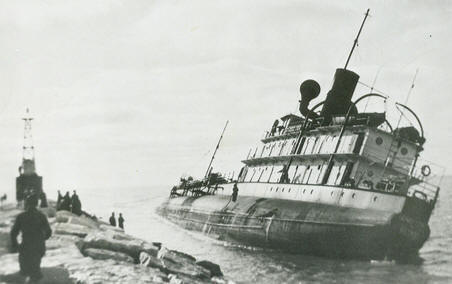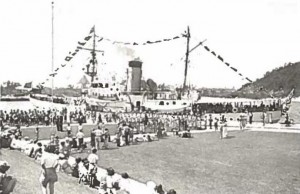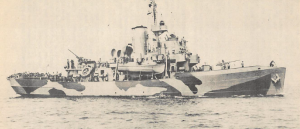
On the frigid morning of Friday, December 9, 1932, citizens of Grand Haven, Michigan gathered on the Government Basin pier. Cheers rose as the United States Coast Guard’s newest cutter, Escanaba, steamed up the channel, saluted the welcoming party, and docked smoothly at a berth still under construction. The cutter looked elegant with her clean white paint freshly “sheathed in ice” from the spray kicked up by the 20 mph winds out on the lake [17, p. 341]. After attempting to play the Coast Guard’s new marching song “Semper Paratus” in the cold, the high school band, along with the rest of the onlookers, received a warm welcome onto the ship from Captain Louis Perkins. With everyone snug in the engine room the band played and the bond between the Escanaba and the people of Grand Haven was formed [17, p. 341].
Escanaba in Grand Haven
Three years earlier, the deadly shipping season of 1929 highlighted the need for improved rescue capabilities on Lake Michigan. In late September the 25 man crew of the gravel carrier Andaste perished when she went down in bad weather on a routine trip from Ferrysburg, Michigan to Chicago. Less than a month later, the railroad car ferry Milwaukee, was lost with all 53 crew members in the worst car ferry accident in Great Lakes history [13, p. 313]. Before the end of the month, the Lake claimed another 26 lives in the wrecks of the passenger steamer Wisconsin and the automobile carrier Senator.
In response, congress allocated money for a new class of light ice-breaking cutters capable of responding to such disasters. The Escanaba was launched from the Defoe Works in Bay City, Michigan in September 1932. Costing half a million dollars, she displaced 1005 tons and had a length, beam and draft of 165’, 36’, and 12’ 3” respectively. Her 1500 horsepower steam turbine engine and 41,605 gallons of fuel could take her 5079 miles cruising at nearly 10 knots or to a top speed of 12.8 knots. She was armed with the maximum allowed at the time by international law including two six-pound guns, two .50 caliber machine guns, and additional small arms [17, p. 340].
A writer for the Grand Haven Tribune captured the excitement and pride felt by Grand Havenites when the Escanaba first arrived in port. The spectacle would have been particularly welcome during the depths of the Great Depression which had nearly eliminated the port’s car ferry traffic [16, p. 210].
The ship, a majestic cutter, the finest of her type, painted white, looked like a battleship as she moved up the river, flags of the United States and cutter service flying, blue coated sailors on the decks and officers on the bridge who guided her easily to the landing place.

Temporarily assigned to Grand Haven on November 23, the exact role and capabilities of the novel cutter (and her five sister ships) were still undetermined. Later in the year, Captain Perkins selected Grand Haven over other West Michigan ports for the cutter’s permanent home [17, p. 341]. Escanaba proved an adept ice-breaker able to break up to two feet, and made yearly trips to help open the St. Mary’s River and cut freighters out of the ice. She extended the shipping season by frequently liberating ferries and saved lives by freeing smaller fishing craft which did not carry enough fuel to survive an extended stay in the ice at sub-zero temperatures. In 1934 she earned the title “mercy ship” after cutting her way from Charlevoix to Beaver Island carrying supplies to residents and livestock otherwise isolated from the mainland [7]. During the summer months she patrolled regattas and awaited the storms that would bring calls for help from the Lake Michigan commercial fleet.
Within three weeks of arriving in Grand Haven, the Escanaba proved her lifesaving ability when she rescued the two pilots of a Kohler Aviation flight from Milwaukee to Grand Rapids just after midnight on December 29. The Escanaba, along with smaller craft from Muskegon, Grand Haven, and Holland, received the call around 6 pm on the 28th when it became clear that the flight was overdue. The lifeboats from Grand Haven and Muskegon were forced back into port by icing conditions while the one from Holland never reached the lake due to ice blocking the way. The Escanaba, able to continue the search because of her size and power, spotted a flare fired by the airmen while they sat on the wings of their still floating aircraft and rescued them along with the four bags of mail on the flight [16, p. 222-223]. Had the Escanaba not been available for the rescue effort, those two men would certainly have perished.

On November 30, 1934, the Escanaba was called up to Muskegon to respond to the whaleback freighter Henry W. Cort which had been blown onto the north side of the Muskegon channel break wall by 45 mph winds. Initial attempts to reach the wrecked freighter by surf boat failed when the small craft was swamped by huge waves. Locals watched around midnight as the Escanaba maneuvered in the punishing waters and employed her search lights in an effort to locate Coast Guardsman John Dipert who had been swept out of the swamped surf boat; however, this proved futile. According to the December 1st issue of the Grand Haven Tribune, signs of life were sighted on-board the Cort at 3 am when lights were flashed in the vessel’s cabin in response to the Escanaba‘s searchlights which had been directed on the wreck. The cutter remained with the wrecked freighter until the following morning when, due to land based efforts by Muskegon coastguardsmen, the entire 25-man crew of the Cort was saved using breeches buoy techniques [18, p. 126-132].
Close relations between the locals and the Escanaba‘s crew marked the cutter’s tenure in Grand Haven. In the days after the cutter’s arrival, The Grand Haven Tribune covered the crew’s activities in detail. Split into two groups to maximize free time, the crew spent the day of the arrival checking out the town. In addition to seeking housing for wives and children yet to arrive, the paper notes that “the ‘Blue Coats’ were seen at the Grand Theatre on the opening night under the new management, at the basketball game, at the Armory dance and in and out the stores and business places all day … getting the lay of the land.” At the same time, the officers were welcomed at an informal dinner which included indiscriminate “razzing” by the toastmaster. The next day the community was welcomed on board the cutter as the crew explained her equipment and operation. The paper notes that young Billie Hatton, “recuperating from an attack of infantile paralysis” (polio) was carried by an officer during his tour of the ship. It was also a point of interest to the community that the cutter was equipped with a “radio for the amusement of the officers and crew”. This was novel technology six years before the famous broadcast of HG Wells’ “War of the Worlds”.

War
In October of 1940, as war spread across Europe and the Pacific, the Escanaba left for Manitowoc, Wisconsin to be refitted. Then, in March 1942, “Escanaba sailed away to war” [17, p. 344]. Gladys Brook, grandmother to the author and lifetime resident of Grand Haven, who was 12 at the time, remembers, “Her work of providing help and rescue for ships on Lake Michigan ended; she left to fight. Havenites were proud that the ship could help in the war.” Despite this pride, Grand Havenites were saddened with the thought that they had lost “their ship” [16, p. 256].

While lacking the size, firepower, and speed of a true destroyer, the Escanaba and her crew truly excelled by rescuing hundreds from Allied transports sunk by submarines. After rescuing only 22 of the USS Cherokee’s 170 passengers on June 15, Lt. Robert Henry Prause, Jr., decided that the brutal conditions in the North Atlantic required new rescue techniques. He developed a method where tethered rescue swimmers in exposure suits pulled survivors from wreckage to the sides of the ship. From there, the crew could then pull them on board. This method helped save over 200 from the SS Dorchester on February 3, 1943 with the Escanaba alone saving 132 [19].
Later that year, the Escanaba, along with her sister cutter Algonquin, four more Coast Guard vessels, the transport Fairfax, and the tanker Laramine set out from Narsarssuak, Greenland for St. John’s, Newfoundland. Just after 5 am on the morning of June 13th, an explosion rocked the Escanaba and she plunged beneath waves so quickly that she never sent a distress signal. Luckily the Storis saw flame and smoke from the explosion and began hunting for submarines while Raritan went to look for survivors. All but two of the of the 103-man crew died in the explosion or succumbed to hypothermia in the 39-degree water before the tug Raritan could pull them to safety [11].
The cause of the Escanaba‘s sinking has never been definitively established. The Coast Guard’s official report on the incident claims, “The most probable explanation is that the loss was caused by mine, torpedo or internal explosion of the magazine and depth charges, but the evidence is not sufficiently conclusive to attach a cause directly or even remotely to any of these.” The report notes that the helmsman Raymond O’Malley, one of the two survivors, heard what might have been the ship’s hydrophone tracking a torpedo, but no U-boat ever claimed the kill [11].
The Spirit Lives On
After learning of the loss of “their cutter,” the citizens of Grand Haven began planning a response. The Junior Chamber of Commerce organized a collection for a memorial fund and capped donations at $2.50 per individual in order that the fund be a “general response … indicative of a community’s grief” [6]. The day after the Tribune carried the gigantic front page headline “ESCANABA IS SUNK” it stated “suggestions have been pouring into the Tribune office since last night. Several have proposed that the next bond drive be launched with the purpose of providing funds which will replace the Escanaba.” On August 4th, six weeks after her sinking, a memorial service at the cutter’s former berth was attended by 20,000. The turnout, more than twice the city’s population, speaks to the greater community’s feeling of loss.
The Coast Guard birthday celebration accompanying the memorial kicked off a drive to sell bonds in hopes of raising $1 million for the construction of a new cutter to bear the name Escanaba. While announcing plans for the observance of Coast Guard Day, the Tribune noted that, “the observance this year will have a more serious aspect than in the days before the war.” Historian David Seibold writes of the Escanaba’s memorial service, “It was at that moment Grand Haven’s annual Coast Guard birthday celebration – today’s Coast Guard Festival – began to mature in meaning and purpose” [17, p. 348].
Bonds purchased for the drive featured a sticker saying, “I remember the Escanaba.” Within a month, the Tribune’s daily thermometer tracking bond sales “exploded” indicating that the million dollar goal had been exceeded 32 days ahead of schedule [2]. In spite of government policy that “war bond dollars could not be earmarked for a particular cause,” the Coast Guard was so impressed by the outpouring that a cutter currently under construction was renamed Escanaba II. Christened on March 25, 1946, the Escanaba II served primarily in the Atlantic by performing rescues and assisting damaged vessels until being decommissioned in 1973 [17, p. 348]. A plaque was placed on the new ship reading, “The citizens of Grand Haven, Michigan in a special patriotic drive, purchased U.S. War Bonds totaling $1,218,000 toward the cost of this ship. This vessel replaces the original Coast Guard Cutter Escanaba lost in 1943.” In 1987, then Mayor Marge Boon referred to the drive as “One of the most extraordinary civic achievements of World War II” [16, p. 277].
The Escanaba II never visited Grand Haven despite hopes that she would be stationed there after the war. However, the newest cutter to bear the name, the Escanaba III, was commissioned there in August of 1987. The ship’s motto, “The Spirit Lives On,” is a tribute to the original Escanaba. According to the Coast Guard Historian’s Office webpage on the Escanaba III, each year the crew honors the sacrifice of the first Escanaba‘s crew through a memorial service on the anniversary of her sinking. In addition the standing captain called Raymond O’Malley, the last living survivor of the sinking until his death in 2007, every June 13th to report the crew’s health, the state of the ship, and that “The Spirit Lives On” [12].

Today the Escanaba‘s wooden mast can be seen in Escanaba Park just west of where she docked when stationed in Grand Haven. Daily during the summer, hundreds walk past on their way to the pier in hopes of catching a sunset. At the beginning of August, crowds gather on the well kept park lawn to watch and cheer as newer cutters make their way into port and open for tours as part of the Coast Guard Festival. While the summer weather is in contrast to that December morning 84 years ago, onlookers can still imagine the excitement felt by those watching as the Escanaba first arrived in the community that would call her “their ship”.
Primary Sources
- “”Blue Coats” Get Antiquated With Citizens.” The Grand Haven Tribune 10 Dec 1932: 1-2.
- “City Exceeds Escanaba Bond Quota.” The Grand Haven Tribune 29 Sept. 1943.
- “Cutter and Local C.G. Station Crew go to Rescue at Muskegon.” The Grand Haven Tribune 1 Dec. 1934: 1-2.
- “Extensive Program for Observance of Coast Guard Day is Planned.” The Grand Haven Tribune 9 July 1943: 1.
- “Hundreds Inspect New Cutter and Government Dock Here; Officers and Crew Explain Ship Devices.” The Grand Haven Tribune 12 Dec. 1932: 1-2.
- “Junior C. of C. Will Raise Fund For Escanaba Memorial.” The Grand Haven Tribune 22 June 1943.
- “Loss of Cutter Escanaba Recalls Its Deeds of Mercy on the Lakes.” The Grand Haven Tribune 19 June 1943: 1.
- “New Cutter’s Officers are Dinner Guests.” The Grand Haven Tribune 10 Dec 1932: 1-2.
- The Sinking of the CGC Escanaba. Report, Statistical Division, U.S. Coast Guard (1943).
- “Weather is Cold but Welcome is Warm as Escanaba Docks Here.” The Grand Haven Tribune 9 Dec. 1932: 1-2.
Secondary Sources
- Browning, Dr. Robert M. (2016). “The Sinking of the USCGC Escanaba”
- Coast Guard News. (2007). “Coast Guard Hero Raymond F. O’Malley Passes Away“
- Meints, Graydon M. (2013) Railroads for Michigan, Michigan State University Press. East Lansing, MI.
- Michigan Shipwreck Research Association. (2016). “Andaste”
- Michigan Shipwreck Research Association. (2016). “Henry Cort”
- Seibold, David H. (1990). Coast Guard City, USA, Historical Society of Michigan. Ann Arbor, MI.
- Seibold, David H. (2007). Grand Haven: In the Path of Destiny, Grand Haven Historical Museum. Grand Haven, MI.
- Sherman, Elizabeth B. (2003). Beyond the Windswept Dunes, Wayne State University Press, Detroit, MI.
- Thiesen, Dr. William H. (2016). “The Long Blue Line”
- United States Census Bureau. (1940). “Census of Population and Housing, 1940”
- United States Coast Guard – Historian’s Office. (2016). “Escanaba, 1932”
Further Reading
- Wikipedia. (2016). “USCGC Escanaba (WPG-77)“
- United States Coast Guard – Historian’s Office. (2016). “Escanaba, 1932”
- United States Coast Guard – Historian’s Office. (2016). “The Spirit Lives On“
